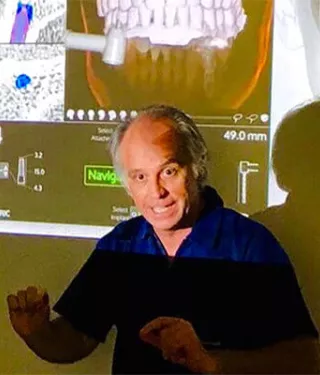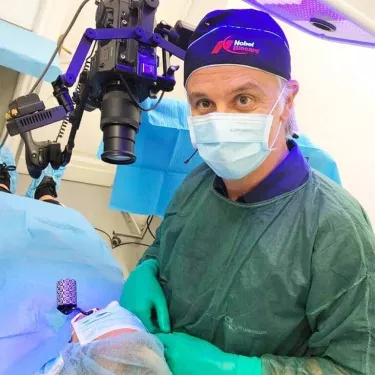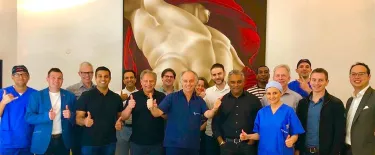
"Almost 70 per cent of my cases are performed with X-Guide®"
Prof. Alessandro Pozzi from Italy explains the advantages of dynamic navigated surgery with X-Guide and why he thinks it will be the new standard of practice for guided implant surgery
An internationally acclaimed implant surgeon from Italy, Prof. Alessandro Pozzi is currently one of the biggest advocates of dynamic navigated surgery, which he performs with the X-Guide system in his dental studio in Rome. In this interview he tells how the technology sparked his interest, how it can help to improve implant treatment outcomes and why he thinks it will be standard of practice in the years to come.
Prof. Pozzi, you have been placing implants for more than 20 years. What sparked your interest in dynamic navigated surgery with the X-Guide system?
I have been placing implants using surgical templates since I entered dentistry back in the 1990s and always thought it to be the perfect way to perform guided surgery. Three years ago, I discovered the X-Nav system through Prof. Peter Moy from the UCLA University of California. I was quite skeptical at first but as a clinical researcher I immediately tried to challenge the system and compare it with static guided surgery in order to find out about the advantages and limits of each approach.
Using a surgical template is a very static concept which means that what we plan with the software cannot be changed or modified thereafter in accordance to the outcome of the surgery or the need to find out a better primary stability for the Immediate Function. With the implant planning dynamically navigated surgery empowered by DTX Studio Implant we now have a very flexible system at our disposal that allows us to adapt our treatment plan in real time and provide quick, safe and predictable treatment outcomes, even in challenging cases or emergencies.
What are the main advantages of dynamic guided surgery with X-Guide compared to static guided surgery?
The main advantage is having full control of the surgery. When placing an implant in an immediate fresh extraction socket, for example, it can be difficult to previsualize the anatomy of the recipient site in the software or be fully confident that the buccal plate is maintained after the extraction. I cannot remember how many times in 15 years I was not perfectly sure about the level of the buccal plate, because it was hidden by the metal artifacts of a PFM crown or post or it was indeed disrupted during the extraction.
With X-Guide you can deliver guided surgery with an open surgical field since there is no template obstructing the view. We can see and immediately adapt to eventual complications, for example when the alveolar wall or a knife-edge shaped edentulous bone crest is driving the drill into the wrong position. With a template you can never visualize those events, as it would need to be removed. With the dynamic navigated concept, we see what is happening in real time and can immediately adapt our plan to overcome complications.
What are the clinical indications for X-Guide?
There are still some clinical scenarios where the use of templates has advantages. However, with the continuous use of X-Guide, I found more and more indications becoming possible to treat. Over the last three years I have been treating single tooth, partial, full arch as well as terminal dentition cases with the navigation system. Performing the latter with a template in particular can be tricky as you need to keep strategic teeth that can support the template and this sometimes is unrealistic and can affect the proper prosthetically driven implant positioning. With dynamic navigated surgery, you don’t need this: you can position the implants exactly where the ideal prosthetic outcome demands.
Looking back at your positive experience with the system so far, what role do you think dynamic navigated surgery will have in the future?
Having performed guided surgery for more than 15 years, the dynamic navigation concept has completely changed how I approach my work. Almost 70 per cent of the cases in my practices are now performed with the help of the X-Guide system. I think that is amazing! My patients can be treated on the same day without the delay of surgical template production.
With this technology, we can really meet patient expectations in terms of reliability and effectiveness. I believe that in a few years we won’t be talking about freehand, static or dynamic guided surgery anymore, because dynamically guided surgery will be the standard of practice. With surgical templates, we often had to make compromises in the past but now the surgeon is in full control of his or her procedure. The good thing is that we are still following the proven concepts we learned from P.I Brånemark and other implant pioneers from the last fifty to sixty years.
X-Guide can be a system for everyone, beginners as well as experienced clinicians who want to challenge themselves to take on more demanding cases with confidence.
What recommendations would you give anyone starting with the X-Guide system?
For beginners it can be a good tool for helping them increase their confidence when they start their career as a surgeon. Especially for clinicians that do not have much surgical experience, X-Guide can be a way to improve the safety and predictability of their treatment. You have to remember, however, that it is not a shortcut and you still need to be knowledgeable in the basics of implant surgery.
Using a template is fine but it always detaches you somewhat from clinical reality. X-Guide is basically like a GPS, which matches the virtual patient with the real patient, and looks over your shoulder in order to guide you through the procedure.
In the last couple of months, I have been training people coming from all over the world on treatment with X-Guide, and it is amazing to see how quickly they are able to overcome the learning curve and improve their clinical performance. From my experience, it usually takes them less than ten procedures to switch from performing simple cases on a model to a real patient.

